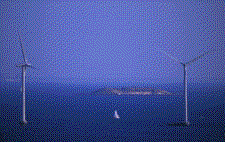
A case study of energy policy in Denmark

Denmark's largest Wind Farm, Middelgrunden
Denmark's wind-turbine construction industry is the
largest in the world. The turbines are the nation's
largest export, with a turnover of more than $800
million. About 13,000 people work for the industry.
In 2002, wind energy contributed to 18% of electricity
consumption. The Danish government initially promoted
wind energy to improve local air quality, but now
their motivation is reducing carbon dioxide emissions.
The Danish Ministry of the Environment and Energy
originally set targets at 10% wind energy in 2005,
but because of the policies' success, the targets
were increased to 16%, and now it is expected to be
21% for 2003 (Danish Wind Industry).
Denmark uses a combination of tax and subsidy policies
that support wind energy. They include voluntary agreements
with electricity utilities on building new capacity,
tax programs and subsidies to non-utility generators.
Some subsidies they use include buy-back rates, tax
benefits and infrastructure standards that mandate
utilities to pay for transmission networks that support
wind-capacity additions and tax benefits.
Subsidies
In 1979, Denmark implemented a subsidy equal to 30%
of wind turbine investment costs. This spurred much
investment and led to the initial deployment of 200-300
machines a year. These subsidies were phased out for
wind power in 1989, after they helped increase the reliability
and decrease the price of turbines. Until 1999, the
government provided direct grants for each kWh turbine
owners sold to the grid.
Now Denmark has about 15 subsidy programs for both
energy production and consumption. The largest subsidy
is a production subsidy per kWh for electricity generated
from renewable energy resources. The majority of the
subsidy schemes "are directed primarily at converting
central and electric heating systems to district heathing
and to expanding and renovating the existing district
heating network" (Renewable
Energy Policy Project)
Denmark's subsidy programs are exemplary models because
they have been temporary and effective.
Taxes
Wind energy is supported by a partial rebate from
the Danish electricity tax. While there is no tax
on the fuels used for electricity, an overall tax
on electricity is used to promote energy efficiency.
Three separate energy taxes also promote the use of
renewables; 1) a tax that varies for natural gas,
unleaded gasoline, diesel fuel and other energy 2)
a carbon dioxide tax and 3) a sulfur dioxide tax.
In addition, Denmark adjusts rates for space heating
and for "heavy" and "light" uses
of energy. Energy taxes account for about 7% of domestic
revenue (REPP).
Denmark has invested more in wind energy than any other
European nation in the last 15 years. Green taxation
policies complement the subsidies by encouraging energy
efficiency. Together they engendered the largest turbine
manufacturing center in the world in a very small country.
For detailed information on Danish tax and subsidy
policies:
Renewable
Energy Policy Project, An overview of Wind
Energy in Denmark
Danish
Wind Industry, Energy Policy Brief
Additional Resources:
Reforming
Energy Subsidies (289 kb .pdf)
International
Institute for Sustainable Development |



